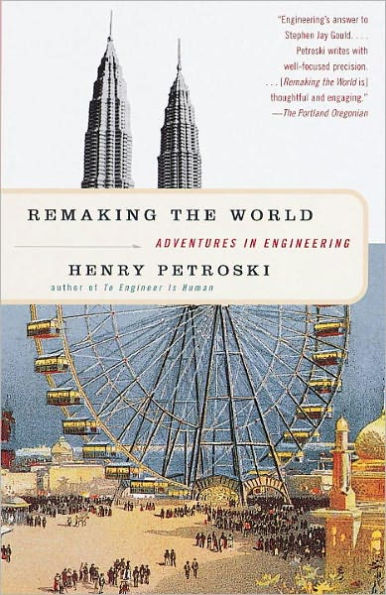This collection of informative and pleasurable essays by Henry Petroski elucidates the role of engineers in shaping our environment in countless ways, big and small.
In Remaking the World Petroski gravitates this time, perhaps, toward the big: the English Channel tunnel, the Panama Canal, Hoover Dam, the QE2, and the Petronas Twin Towers in Malaysia, now the tallest buildings in the world. He profiles Charles Steinmetz, the genius of the General Electric Company; Henry Martyn Robert, a military engineer who created Robert's Rules of Order; and James Nasmyth, the Scotsman whose machine tools helped shape nineteenth-century ocean and rail transportation. Petroski sifts through the fossils of technology for cautionary tales and remarkable twists of fortune, and reminds us that failure is often a necessary step on the path to new discoveries. He explains soil mechanics by way of a game of "rock, scissors, paper," and clarifies fundamental principles of engineering through the spokes of a Ferris wheel.
Most of all, Henry Petroski continues to celebrate the men and women whose scrawls on the backs of envelopes have immeasurably improved our world.
1117245280
In Remaking the World Petroski gravitates this time, perhaps, toward the big: the English Channel tunnel, the Panama Canal, Hoover Dam, the QE2, and the Petronas Twin Towers in Malaysia, now the tallest buildings in the world. He profiles Charles Steinmetz, the genius of the General Electric Company; Henry Martyn Robert, a military engineer who created Robert's Rules of Order; and James Nasmyth, the Scotsman whose machine tools helped shape nineteenth-century ocean and rail transportation. Petroski sifts through the fossils of technology for cautionary tales and remarkable twists of fortune, and reminds us that failure is often a necessary step on the path to new discoveries. He explains soil mechanics by way of a game of "rock, scissors, paper," and clarifies fundamental principles of engineering through the spokes of a Ferris wheel.
Most of all, Henry Petroski continues to celebrate the men and women whose scrawls on the backs of envelopes have immeasurably improved our world.
Remaking the World: Adventures in Engineering
This collection of informative and pleasurable essays by Henry Petroski elucidates the role of engineers in shaping our environment in countless ways, big and small.
In Remaking the World Petroski gravitates this time, perhaps, toward the big: the English Channel tunnel, the Panama Canal, Hoover Dam, the QE2, and the Petronas Twin Towers in Malaysia, now the tallest buildings in the world. He profiles Charles Steinmetz, the genius of the General Electric Company; Henry Martyn Robert, a military engineer who created Robert's Rules of Order; and James Nasmyth, the Scotsman whose machine tools helped shape nineteenth-century ocean and rail transportation. Petroski sifts through the fossils of technology for cautionary tales and remarkable twists of fortune, and reminds us that failure is often a necessary step on the path to new discoveries. He explains soil mechanics by way of a game of "rock, scissors, paper," and clarifies fundamental principles of engineering through the spokes of a Ferris wheel.
Most of all, Henry Petroski continues to celebrate the men and women whose scrawls on the backs of envelopes have immeasurably improved our world.
In Remaking the World Petroski gravitates this time, perhaps, toward the big: the English Channel tunnel, the Panama Canal, Hoover Dam, the QE2, and the Petronas Twin Towers in Malaysia, now the tallest buildings in the world. He profiles Charles Steinmetz, the genius of the General Electric Company; Henry Martyn Robert, a military engineer who created Robert's Rules of Order; and James Nasmyth, the Scotsman whose machine tools helped shape nineteenth-century ocean and rail transportation. Petroski sifts through the fossils of technology for cautionary tales and remarkable twists of fortune, and reminds us that failure is often a necessary step on the path to new discoveries. He explains soil mechanics by way of a game of "rock, scissors, paper," and clarifies fundamental principles of engineering through the spokes of a Ferris wheel.
Most of all, Henry Petroski continues to celebrate the men and women whose scrawls on the backs of envelopes have immeasurably improved our world.
4.99
In Stock
5
1

Remaking the World: Adventures in Engineering
256
Remaking the World: Adventures in Engineering
256Related collections and offers
4.99
In Stock

Product Details
| ISBN-13: | 9780307773203 |
|---|---|
| Publisher: | Knopf Doubleday Publishing Group |
| Publication date: | 01/05/2011 |
| Sold by: | Random House |
| Format: | eBook |
| Pages: | 256 |
| File size: | 2 MB |
About the Author
From the B&N Reads Blog
